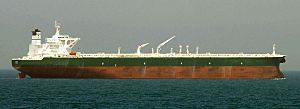Oil tanker facts for kids
An oil tanker is a special kind of ship. It is built to carry huge amounts of oil across the oceans. These powerful ships are also called petroleum tankers.
There are two main types of oil tankers. The first is a crude tanker. These giant ships move raw, unrefined crude oil. They pick up oil from where it is found, like oil wells. Then, they carry it to places called refineries. Refineries turn crude oil into useful products.
The second type is a product tanker. These ships are usually smaller. They carry refined oil products, like petrochemicals. These products are moved from refineries to places where people use them. Think of it like a big delivery truck for the sea!
Contents
What Are Oil Tankers?
Oil tankers are essential for moving energy around the world. They help deliver the fuel we use every day. This includes gasoline for cars and heating oil for homes. Without these ships, it would be very hard to get oil where it's needed.
How Big Can Tankers Get?
Oil tankers come in many sizes. Some are quite small, used for short trips. Others are truly enormous. The biggest ones are called supertankers. These ships can be as long as several football fields! They can carry millions of barrels of oil at once. Imagine a floating city, but filled with oil!
Crude Oil Tankers Explained
Crude oil tankers are designed for long journeys. They travel between continents. They pick up crude oil from countries that produce it. Then, they deliver it to countries that need it for energy. These ships have huge tanks inside. They are built to be very strong and safe.
Product Tankers Explained
Product tankers carry different types of refined oil. This can include gasoline, diesel, and jet fuel. They often make shorter trips. They move products from refineries to ports closer to cities. These ships have many separate tanks. This allows them to carry different products at the same time.
How Oil Tankers Work
Oil tankers use powerful pumps to load and unload oil. They connect to special pipes on land. These pipes are called marine loading arms. The oil flows through these arms onto or off the ship. It's a bit like filling up a giant gas tank!
Loading and Unloading Oil
When an oil tanker arrives at a port, it connects to the shore. Large hoses or arms are used for this. Powerful pumps on the ship or on land move the oil. This process is done very carefully. Safety is super important to prevent spills.
Inside the Tanks
The inside of an oil tanker is divided into many sections. These are called cargo tanks. Each tank can hold a huge amount of oil. Modern tankers often have a "double hull." This means they have two layers of steel. This extra layer helps protect the oil if the ship is damaged. It makes them safer for the environment.
History of Oil Tankers
The first oil tankers were built in the late 1800s. Before that, oil was carried in barrels. This was slow and dangerous. The idea of putting oil directly into a ship's hull changed everything. It made transporting oil much faster and cheaper.
Early Tanker Designs
One of the very first oil tankers was the Zoroaster. It was built in 1878. It carried oil on the Caspian Sea. Another important early tanker was the Glückauf. It was built in 1886. These early ships helped show how useful tankers could be.
Safety and the Environment
Oil tankers play a big role in global trade. Because they carry so much oil, safety is very important. Accidents can cause oil spills. These spills can harm the ocean and wildlife.
Preventing Oil Spills
New rules and technologies help make tankers safer. The double hull design is one example. Tankers also have strict rules for how they operate. Crews are highly trained. All these efforts help protect our oceans.
Images for kids
-
Falls of Clyde is the oldest surviving American tanker and the world's only surviving sail-driven oil tanker.
-
Glückauf grounded in heavy fog at Blue Point Beach on Fire Island.
-
A Royal Dutch Petroleum dock in the Dutch East Indies (now Indonesia)
-
Knock Nevis (1979–2010), a ULCC supertanker and the longest ship ever built.
-
Exxon Valdez spilled 10.8 million US gallons (41,000 m3) of oil into Alaska's Prince William Sound.
See also
 In Spanish: Petrolero para niños
In Spanish: Petrolero para niños




















